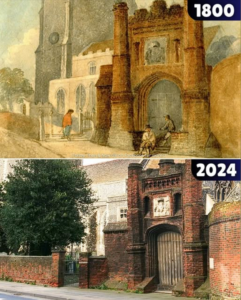Wolsey’s Gate in Ipswich stands as a silent witness to a grand vision that was never fully realized. Originally part of Cardinal Wolsey’s ambitious plan to establish a college rivaling Eton, the gate is now the only remaining structure from what could have been one of England’s most prestigious educational institutions. Over the centuries, it has endured political upheaval, demolition, and the passage of time, yet it remains an iconic historical landmark in Ipswich.
The Ambition Behind Wolsey’s College
Cardinal Wolsey’s Grand Vision
In the early 16th century, Cardinal Thomas Wolsey, one of the most powerful figures in England under King Henry VIII, set out to establish a college in his hometown of Ipswich. His goal was to create an educational institution that would rival Eton College, providing top-tier education for young scholars. Wolsey was known for his deep interest in learning and the arts, and he envisioned a center of academic excellence that would elevate Ipswich’s status.
A Project Cut Short
Wolsey’s influence began to wane when he fell out of favor with King Henry VIII. His failure to secure the annulment of the king’s marriage to Catherine of Aragon led to his downfall. In 1530, before the college could be completed, the project was abandoned, and much of the structure was demolished. The only surviving remnant of this grand endeavor is what we now know as Wolsey’s Gate.

The Architectural Significance of Wolsey’s Gate
A Glimpse into Tudor Design
Wolsey’s Gate is a fine example of Tudor architecture, featuring red brick construction, intricate masonry, and decorative elements that reflect the period’s design aesthetics. Though the college itself was never completed, the gate offers valuable insights into the architectural style and ambitions of the era.
The Role of the Gate
The gate likely served as the grand entrance to the college, welcoming students and scholars into what was meant to be a prestigious institution. Despite the destruction of the rest of the college, the gate has remained intact, a testament to the craftsmanship and durability of Tudor-era construction.
The Transformation of Wolsey’s Gate Over the Centuries
An Evolving Landscape
Since the demolition of the college in the 16th century, Ipswich has undergone significant changes, yet Wolsey’s Gate has remained a steadfast landmark. Over the years, it has been repurposed and incorporated into the town’s evolving landscape.
A Historical Comparison
An old painting from 1800 captures Wolsey’s Gate as it stood over two centuries ago. When compared to its present-day appearance, it is remarkable how well it has endured the test of time. Despite urban development and environmental changes, the gate still stands as a historical beacon in Ipswich.

The Enduring Legacy of Wolsey’s Gate
A Symbol of Ipswich’s History
Today, Wolsey’s Gate is more than just an architectural relic; it represents Ipswich’s rich history and the legacy of one of England’s most influential figures. It serves as a reminder of the ambition, power, and ultimate downfall of Cardinal Wolsey, whose dreams for the college were never realized.
Preservation Efforts
As a Grade 1 listed structure, Wolsey’s Gate is recognized for its historical and architectural significance. Conservation efforts have ensured that it remains protected for future generations to appreciate. Local historians and heritage organizations continue to advocate for its preservation, recognizing its importance as a cultural landmark.
Conclusion
Wolsey’s Gate in Ipswich is a fascinating piece of history, embodying both the ambition and the tragedy of Cardinal Wolsey’s unfulfilled dream. While the grand college he envisioned was never completed, the gate remains a lasting symbol of his influence and a cherished landmark in Ipswich. Whether viewed through historical paintings or in person today, it continues to capture the imagination of those who appreciate England’s rich architectural and historical heritage.
